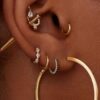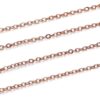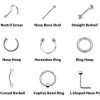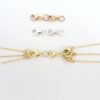Nose Piercing
The Meaning of Nose Piercing – Spiritual Meaning, and Modern Interpretations
Ever noticed a nose piercing and wondered about its story? While they’re definitely in style, there’s a rich history and cultural background many of us don’t know. Plus, did you know the placement and even the wearer’s gender can change its meaning? In a world where trends come and go, understanding the depth of such traditions is truly valuable. Dive into this guide to get the full scoop on nose piercings, blending style with knowledge.
Highlights:
- Nose piercings through time.
- Their cultural and spiritual ties.
- What do different placements signify?
- How men and women wear them differently.
- Today’s take on nose piercings.
- The good and not-so-good about getting one.
- Addressing common questions.
Contents
- 1 The History of Nose Piercing
- 2 The Culture and Spirituality of Nose Piercing
- 3 Meaning of Nose Piercing on the Left Side
- 4 Meaning of Nose Piercing on the Right Side
- 5 Meaning of Nose Piercing Sexually
- 6 Nose Piercing Meaning by Location
- 7 Nose Piercing Meaning on Women
- 8 Nose Piercing Meaning on Men
- 9 Modern Meaning of Nose Piercing
- 10 The Risks and Benefits of Nose Piercing
- 11 FAQs
- 12 Conclusion
The History of Nose Piercing
Nose piercing has its roots in the Middle East, where it was a cherished tradition. This cultural emblem then traveled to India, introduced by the Moghul emperors in the 16th century. In India, it evolved to symbolize beauty, social standing, and marital status for women. Beyond its aesthetic appeal, nose piercing was also believed to offer health benefits, including alleviating menstrual discomfort and easing childbirth pains, drawing from Ayurvedic medicinal principles.
In other parts of the world, such as Africa and Australia, nose piercing was also practiced by various tribes and cultures for different reasons. For example, the Berber and Beja tribes of Africa wore nose rings as a sign of wealth and nobility. The Aborigines of Australia pierced their septum (the cartilage between the nostrils) as a rite of passage for young men. In some Native American tribes, nose piercing was also a way of honoring one’s ancestors or expressing one’s identity.
In the Western world, nose piercing became popular in the 20th century, especially among the punk and hippie subcultures. It was seen as a form of rebellion, self-expression, and individuality. Later on, nose piercing also became more mainstream and fashionable, with celebrities and influencers sporting various styles and designs.
The Culture and Spirituality of Nose Piercing
Nose piercing has different meanings and symbolism depending on the culture and religion of the wearer. Here are some examples:
- In Hinduism, nose piercing is considered a sacred tradition that enhances the beauty and femininity of women. It is also associated with the goddess Parvati, who is the symbol of marriage, fertility, and power. Some Hindu women wear a nose ring called a nath on their wedding day as a sign of loyalty and devotion to their husbands.
- In Islam, nose piercing is not prohibited by the Quran or the Hadith (the teachings of Prophet Muhammad), but it is discouraged by some scholars and clerics who consider it a form of mutilation or imitation of non-Muslims. However, some Muslim women still choose to pierce their noses as a personal choice or a cultural tradition.
- In Judaism, nose piercing is not forbidden by the Torah (the Jewish law), but it is frowned upon by some rabbis and communities who view it as a violation of the commandment to not make any marks on one’s body. However, some Jewish women still pierce their noses as a way of expressing their identity or honoring their heritage.
- In Buddhism, nose piercing is not a common practice among followers, but it is not condemned either. Some Buddhists may pierce their noses as a form of meditation or mindfulness, or as a reminder of the impermanence and suffering of life.
- In Christianity, nose piercing is not explicitly mentioned in the Bible, but it is generally accepted by most denominations as a matter of personal preference or conscience. Some Christians may pierce their noses as a way of glorifying God or showing their faith.
Meaning of Nose Piercing on the Left Side
Historically, the side of the nose piercing carried specific significance in different cultures. In India, for instance, the left side was traditionally chosen for nose piercings, especially for young women, as it was believed to be associated with the reproductive organs and could help in reducing childbirth and menstrual pain.
Meaning of Nose Piercing on the Right Side
While the left side holds a particular significance in some cultures, the right side isn’t devoid of meaning. In some traditions and communities, a piercing on the right might signify a particular life event or be rooted in local customs. However, as societies evolved and global influences mixed, the strict adherence to one side has become more relaxed. Today, many people choose the side based on personal preference and aesthetic appeal.
Meaning of Nose Piercing Sexually
Nose piercings, like many forms of body art, can carry a range of personal meanings for the wearer, including expressions of sexuality and identity. Some people believe that certain piercings can symbolize sexual orientation or certain kinks, but it’s essential to approach such interpretations with caution. Over time, as the global popularity of nose piercings has risen, many wear them as a statement of personal style rather than a declaration of sexuality. It’s always best to refrain from making assumptions and respect each individual’s choice of expression.
Nose Piercing Meaning by Location
Nose piercing can be done in different locations on the nose, such as the nostril, the septum, the bridge, the high nostril, or the nasallang. Each location can have its own meaning and significance for the wearer. Here are some examples:
Nostril piercing:
This is the most common type of nose piercing that involves piercing either the left or right nostril. It can be done with a stud, ring, or hoop. Some people believe that piercing the left nostril has spiritual benefits for women while piercing the right nostril has positive effects for men. However, this is not a universal rule, and ultimately it comes down to personal preference.
Septum piercing:
This is another popular type of nose piercing that involves piercing the septum (the cartilage between the nostrils). It can be done with a ring or barbell. Some people believe that septum piercing has tribal or warrior connotations, while others see it as a fashion statement or an expression of personality.
Bridge piercing:
Nose Bridge piercing is a less common type of nose piercing that involves piercing the skin between the eyes (the bridge of the nose). It can be done with a barbell or curved barbell. Some people believe that bridge piercing enhances one’s vision or intuition, while others find it aesthetically pleasing or unique.
High nostril piercing:
This is a rare type of nose piercing that involves piercing the upper part of the nostril, near the eye. It can be done with a stud or ring. Some people believe that high nostril piercing has spiritual or mystical implications, while others like it for its subtle or elegant appearance.
Nasallang piercing:
This is a very rare and complex type of nose piercing that involves piercing both nostrils and the septum at the same time, with a single piece of jewelry. It can be done with a barbell or industrial barbell. Some people believe that nasallang piercing has a powerful or intimidating effect, while others enjoy it for its challenge or uniqueness.
Nose Piercing Meaning on Women
Nose piercing on women can have different meanings depending on the culture, religion, and personal preference of the wearer.
In some cultures, such as India, nose piercing is a traditional practice that signifies beauty, femininity, and marital status. In others, such as the Western world, nose piercing is a modern trend that expresses individuality, style, and fashion. Some women also pierce their noses for spiritual reasons, such as enhancing their intuition, connecting with their ancestors, or honoring their goddesses. Whatever the reason, nose-piercing on women can be a powerful way of expressing one’s identity and personality.
Nose Piercing Meaning on Men
Nose piercing on men can also have various meanings depending on the context and the choice of the wearer. In some cultures, such as Africa and Australia, nose piercing was a sign of bravery, strength, and warrior spirit.
In others, such as the Middle East and Native America, nose piercing was a symbol of wealth, nobility, and leadership.
In the modern world, nose-piercing on men can be a way of showing one’s artistic, adventurous, or rebellious side. Some men also pierce their noses for spiritual reasons, such as improving their concentration, trusting in God, or manifesting their divinity. Whatever the meaning, nose piercing on men can be a bold and unique statement of one’s character and beliefs.
- Read: Septum Piercing Men
Modern Meaning of Nose Piercing
Although nose rings are still frowned upon by certain sections of Western society, today they have generally become an accepted practice.
In the West, a nose piercing is seen as only a fashion accessory and holds little cultural or historical significance. However, this does not mean that nose rings are meaningless for everyone who wears them.
Some people may choose to pierce their noses for personal reasons, such as expressing their identity, personality, or style.
Some may also pierce their noses for spiritual reasons, such as following a certain faith, honoring a deity, or seeking enlightenment. Some may also pierce their noses for aesthetic reasons, such as enhancing their appearance, complementing their features, or creating a contrast. Whatever the reason, nose rings can be a way of showing one’s individuality and creativity in the modern world.
The Risks and Benefits of Nose Piercing
Like any other form of body modification, nose piercing has its pros and cons.
Here are some of them:
Risks:
Nose piercing can cause pain, bleeding, swelling, infection, scarring, allergic reactions, or rejection. It can also damage the nerves, cartilage, or blood vessels in the nose. It can also interfere with breathing, smelling, or tasting. It can also pose problems for medical procedures, such as X-rays or surgery. It can also be frowned upon by some employers, schools, or social groups.
Benefits:
Nose rings can enhance one’s appearance, confidence, or self-esteem. It can also express one’s identity, personality, or style. It can also reflect one’s culture, religion, or spirituality. It can also provide health benefits, such as relieving headaches, sinusitis, or menstrual cramps. It can also stimulate certain acupressure points in the nose that can improve one’s well-being.
Related
- Is Titanium Good For Nose Piercings
- Foods To Avoid After Nose Piercing
- What Gauge Is A Nose Piercing
- Types of Nose Rings
- Nose Piercing Placement
- How To Reopen A Closed Nose Piercing
- How to Put in Hoop Nose Ring
FAQs
Here are some frequently asked questions about nose piercing:
How much does nose piercing cost?
The cost of nose piercing depends on several factors, such as the type of piercing, the location of the piercer, the quality of the jewelry, and the aftercare products. Generally speaking, nose piercings can range from $20 to $100 or more.
How long does nose piercing take to heal?
The healing time of nose piercing varies depending on the type of piercing, the quality of the jewelry, and the aftercare routine. Generally speaking, nostril piercings take about 2 to 4 months to heal completely, while septum piercings take about 6 to 8 weeks to heal fully.
How to clean nose piercing?
The best way to clean nose piercing is to use a saline solution (a mixture of salt and water) twice a day. You can either buy a ready-made saline spray or make your own by dissolving 1/4 teaspoon of sea salt in 8 ounces of warm water. You can then apply the solution to your piercing with a cotton ball or swab, gently removing any crust or debris. You should also avoid touching your piercing with dirty hands or objects, and avoid using alcohol, hydrogen peroxide, soap, or other harsh chemicals that can irritate your piercing.
How to change nose piercing?
The best time to change nose piercing is when it is fully healed and free from any signs of infection or inflammation. You should also have a new piece of jewelry ready that is made of high-quality material (such as titanium, gold, or surgical steel) and fits your piercing snugly. You should then wash your hands and your jewelry with soap and water, and gently remove your old jewelry from your piercing. You should then insert your new jewelry into your piercing carefully and securely. You should then clean your piercing with saline solution and monitor it for any signs of irritation or rejection.
How to hide nose piercing?
There are several ways to hide nose piercing if you need to do so for work, school, or other reasons. One way is to use a clear or flesh-colored retainer (a small piece of plastic or glass that holds your piercing open) instead of your regular jewelry. Another way is to use a small band-aid or makeup to cover your piercing discreetly. However, you should only do this when your piercing is fully healed and for short periods of time. You should also avoid using any products that can clog your piercing or cause an allergic reaction.
Conclusion
Nose piercing is a fascinating and diverse practice that has many meanings and symbolism across cultures and religions. It is also a personal and creative choice that can have various effects on one’s physical and mental health. If you are interested in getting your nose pierced, make sure you do your research, find a reputable piercer, and follow the aftercare instructions. Remember that nose piercing is not for everyone, and it is ultimately up to you to decide if it is right for you.
More By Miami Jewelry Co:
- What Size Needle is Used for Nose Piercing
- Septum Stretching
- Are nose piercings unprofessional?
- Double Nose Piercing
- Triple Nose Piercings
- Rhino Piercing
- Foods To Avoid After Nose Piercing
- Nose Piercing on Big Nose Look

Camila Luna is a passionate jewelry enthusiast and content creator at Miami Jewelry Co. With a focus on providing high-quality, Miami-style jewelry, Camila and her team specialize in a wide range of jewelry that includes bracelets, necklaces, earrings, and more












